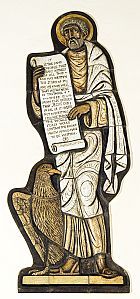The Gospel of Matthew
The Story of Matthew

Matthew and Mark's framework
The three comparisons I suggested show us how the story of both Matthew and Mark moves from the baptism of Jesus (Mt 4,17 & Mk 1,11) to his transfiguration (Mt 17,5 & Mk 9,7), with Jesus in Galilee for most of the time between the two events. In both Gospels, Jesus' journey to Jerusalem begins after the transfiguration. Arriving in Jerusalem, Jesus has a period of teaching and preaching before his Passion follows. The two Gospels have the same last words of Jesus from the cross and the same cry by the centurion (Mt 27,54 & Mk 15,39). Thus both Gospels have the same outline story.
Yet Matthew has adapted and recast the Gospel of Mark for his purposes. First, there are two key phrases which form a bracket around the whole Gospel.
Mt 1,23 announces the soon to be born Jesus as "Emmanuel". The evangelist explains that this means "God is with us"
Mt 28,20 form the last words of the Gospel with the proclamation of the risen Christ: "I am with you always".
Just to complete this, in the middle of the Gospel Jesus says to his disciples: "Where two or three are gathered in my name, there I am in the midst of them" (Mt 18,20).
We can therefore conclude that for Matthew, the continuing presence of Christ with his Church (Mt 18,17) is all important. We will be seeing that as a result Matthew does not place much emphasis on the role of the Holy Spirit. It is rather in the Gospels of Luke and John that special importance is given to the Holy Spirit.
The Five Discourses
The most well known feature of the Gospel of Matthew is his presentation of the teaching of Jesus in five discourses.
The five references I gave all say "When Jesus had finished these sayings" or something similar. There is a special stress in Mt 26,1 with "all these words". You needed therefore to look for the beginning of each discourse. Thus in the first, third and fifth, Jesus begins by sitting down, a formal teaching position for a rabbi (Mt 5,1; 13,1; 24,3). For the second, Jesus is instructing his disciples (Mt 10,5) whilst the fourth begins with a question by the disciples (Mt 18,1).
We can list the five discourses as follows:
- The Sermon on the Mount (Mt 5,1-7,27)
- The Missionary Discourse (Mt 10,5-42)
- The Parables of the Kingdom (Mt 13,1-52)
- The Community Discourse (Mt 18,1-35)
- The Discourse about the End (Mt 24,3-25,46)
Noteworthy is that the centrepiece of the five discourses is the parables of the kingdom in chapter 13.
The Mountain
In addition, I gave you another seven references all of which you will have seen refer to mountains. Mountains are an important setting for a scene because they form the meeting place of heaven and earth. In the Bible, a mountain is the special place of God's revelation: Mount Sinai most obviously, which is why I suggested looking at Exodus 19. Other mountains can also be included in the symbolism, notably Mount Zion as in Psalm 48 for example. The Mount of Olives (24,3) is the place where the Messiah is expected to be revealed at the end of time (Zechariah 14,4). It is the only one of these mountains in Matthew which is named.
(It is unfortunate that some translations, including the Jerusalem Bible, choose to translate the word as "hills". That is a possible reading of the Greek but it misses the point.)
The seven mountain scenes of Matthew can be listed as:
- the mountain of testing (Mt 4,8)
- the mountain of teaching (Mt 5,1)
- the mountain of prayer (Mt 14,23)
- the mountain of healing and feeding (Mt 15,29)
- the mountain of transfiguration (Mt 17,1)
- the mount of Olives (Mt 24,3)
- the mountain of commissioning (Mt 28,16)
Therefore these seven mountain scenes are places of special significance in the Gospel of Matthew. Seven itself was regarded as the number of wholeness or completeness. We will explore the importance of this setting in more detail once we have read through the Gospel and come to the mountain right at the end (28,16).
Return to the main page.
Comparing Matthew with Mark
Looking at the comparisons I gave:
Mt 4,12 & Mk 1,15: Matthew has adapted Mark so that he could include a quotation from the prophet Isaiah. Such OT quotations are important for Matthew as we shall see.
Mt 9,18-26 & Mk 5,21-43: Matthew tells the two stories in 9 verses whereas Mark takes 23 verses. Matthew's Gospel may be longer than Mark's but the various incidents are usually told quite sparsely. Mark clearly likes telling a good story with all the details as in the execution of John the Baptist (Mk 6,14-29) which is trimmed by Matthew (Mt 14,1-12).
Mt 16,13-17,8 & Mk 8,27-9,8: whilst they differ in their details, Matthew follows Mark's sequence at this crucial turning point of the Gospel. In these verses which take us from Caesarea Philippi to the mountain of the Transfiguration we find Jesus preparing to leave Galilee behind and turning his face towards Jerusalem.(We can note that the Gospel of Luke makes far more of this journey to Jerusalem than Mark or Matthew. Taking all of ten chapters, the journey becomes the setting for much of Jesus' teachng in this Gospel).
Mt 27,45-54 & Mark 15,33-39: The death of Jesus is quite similar in both Gospels with the opening verse of psalm 22 ("My God, my God why have you forsaken me") as the last words of Jesus (Luke and John give different final exclamations). Matthew though adds the cosmic upheavals (which continue into the resurrection).
Return to move on and begin our reading of the Gospel.
